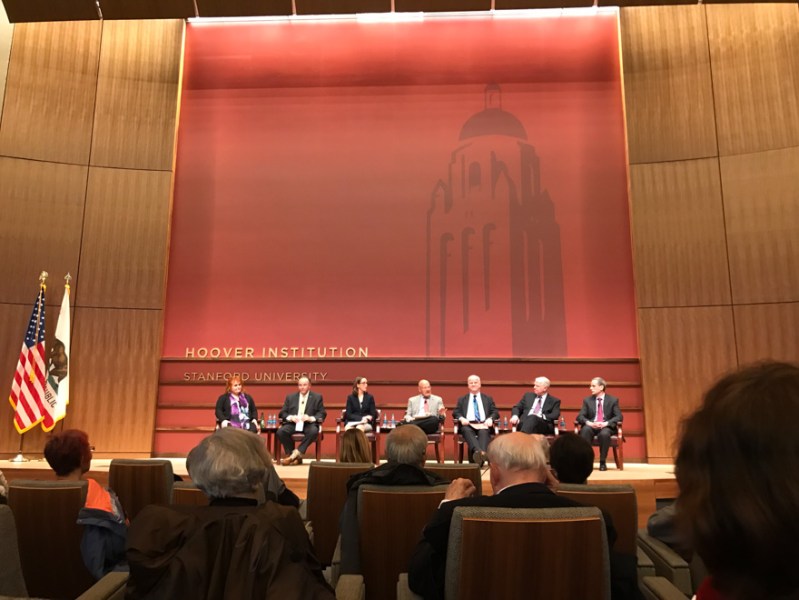The Hoover Institute’s “Governance in an Emerging New World” series, organized by former secretary of state George Shultz, has traversed different regions of the world to address the challenges of rapid development. Monday’s event, the seventh in the series, specifically focused on the state of military technological innovation in the United States and China and addressed its implications for a changing strategic dynamic in the global sphere.
Technology and the military
Political science Ph.D. candidate Katie Hedgecock drew from her experience as a junior officer in the United States Army to discuss the threats and difficulties that arise from employing technology in the battlefield. She emphasized organizational culture as the backbone of military success.
“The army is a ‘soldier-first’ organization,” she said. “It is about leadership and it is about people. Integrating technology cannot be a disruption to the brotherhood or sisterhood of our soldiers.”
Technology can act as a potential threat to that culture when the level of knowledge needed makes the barrier to entry high, Hedgecock said.
“We have inadvertently created high value targets, which means the commander on the field has no option but to expend extra resources on protecting that technical knowledge, and that is a distraction from the larger fight,” Hedgecock explained. “It’s like guarding your queen in chess without paying attention to how to win the actual game of chess.”
She also discussed the significance of today’s soldiers mostly being between the ages of 18 and 24.
“The good news is by being in this generation our soldiers are technologically literate,” she said, but with the caveat that over-dependency on this technological literacy can be a drawback.
According to Hedgecock, technology always leaves an “electronic footprint,” which compromises concealment in the battlefield — soldiers need to be able to operate without it.
“What happens when we take away these devices? We need to [be able to] fight the fight when technology is not present,” she said.
Strategic competition with China
Most of the panelists agreed that there was indeed a phase when China imitated the United States’ technology, but that the country has since moved to a stage of pursuing its own rapid innovation.
Former Chief of Naval Operations Admiral Gary Roughead, who is also the Robert and Marion Oster Distinguished Military Fellow, criticized past U.S. military intervention, explaining that insurgencies have not failed due to a tactical problem, but a strategic one.
“We never understand the fight[s] we are getting into,” he added.
Roughead also explained that the U.S. military has “failed” in countries like Vietnam, Afghanistan and Iraq when it tried to “fix” their countries. On the other hand, he sees the military interventions in El Salvador, Philippines and Colombia as strategic successes stemming from small and indirect action.
“All these are success because we didn’t try changing the countries,” Roughead pointed out. “Our problem in not technology but strategy.”
Colonel Thomas X. Hammes, who serves as a senior research fellow at the National Defense University, saw technical education in the U.S. as lacking compared to the academic programs that China is making available to its youth.
Several audience members were concerned by just how important the “China Question” regarding the effects of the country’s rising power, actually is.
One of these individuals was Chelsea Berkey, a graduate student in the Ford Dorsey Master’s in International Policy (MIP) program studying national security who said she was interested in how much focus should be placed on China.
“My professors are all very concerned with China,” she began. “Its rise [in great power politics] is something that needs to be considered, but what if we should be paying attention elsewhere?”
In response to questions regarding the emphasis on China in academic discourse, event organizer George Shultz also emphasized the importance of realism.
“The world is right at a moment when we have a hinge of history,” Shultz said. “Instead of a vindictive settlement after World War II we reached out to Germany and Japan and helped them become democracies and strong economies […] We have to be completely realistic about what’s going on. Then we must make sure we are strong, not just militarily but also with purpose and confidence.”
Another audience member asked how other states, such as Russia and China, compel innovation in technology when profit does not come to play, given that much of their innovation comes from the public sector. In response to the question, some panelists suggested that China and Russia’s research is more ahead on theoretical science but not as much on applied technologies.
Steve Rowe, an audience member, said he felt one of the biggest problems with national security issues is a lack in long-term focus.
“One administration comes in, and the next administration comes in and throws it all away — and we take steps backwards,” he said. “Being more focused in the long term is something we have lost our ability in doing.”
Another audience member, Jim Carson, was surprised by some of the views expressed in the panel, saying that he perceived some panelists’ anti-war comments as almost left-leaning.
Hedgecock ended the event by emphasizing action, citing societal fears of missteps in policy.
“There is a cultural fear of getting things wrong,” she said. “We are so paralyzed with this belief…We should be aiming to make the best decision possible with the technology we have and then having the forgiveness and risk tolerance to keep moving forward.”
This article has been corrected to reflect the accurate spelling of George Shultz’s name, as well as the countries he referred to in his quote about World War II. The Daily regrets these errors.
Contact Theodora Boulouta at boulouta ‘at’ stanford.edu.
